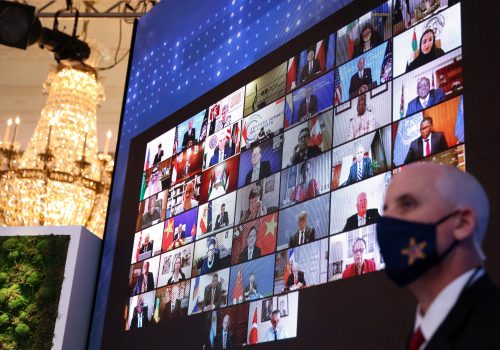African contributions to the climate finance conversation
On Monday, May 17, the Africa Center hosted an event on how to foster inclusive, green growth for African countries, featuring an esteemed panel of industry leaders and experts. The event also served as the launch of Ms. Emilie Bel’s new Africa Center report, Growing Green: Catalyzing Climate Finance in African Markets. Bel is an International Financial Expert and World Bank Consultant.
Panelists included Ms. Tariye Gbadegesin, managing director and chief executive officer of ARM-Harith Infrastructure Investment LTD; Mr. Jake Levine, the chief climate officer at the U.S. International Development Finance Corporation (DFC); Ms. Courtney Lowrance, managing director for sustainability and corporate transitions at Citi; Mr. Admassu Tadesse, group managing director and chief executive officer of the Eastern and Southern African Trade and Development Bank (TDB); and Mr. Bertrand Walckenaer, deputy chief executive officer of the French Development Agency (AFD).
In her opening remarks, Africa Center Director Amb. Rama Yade noted the Center’s vision and expanding programming around climate issues. She expects African voices to be represented in climate discussions and drew attention to a recent piece she published, around the Leaders Summit on Climate in Washington, recalling that while home to 15 percent of the world’s population, Africa is responsible for only 4 percent of global carbon emissions. Meanwhile, Africa faces droughts, floods, declining agricultural productivity, deforestation, difficult access to water, rising seas, advancing deserts, and a rural exodus. She stressed that the mobilization of billons in infrastructure will be necessary, but this starts with getting the financing right.
After personally congratulating Jake Levine on his new position as the chief climate officer of the DFC, she also recognized TDB’s shared commitment in the space and generous partnership on the report.
As the report author, Bel provided brief remarks on why growth in Africa must be green, outlining four highlights from the report. She noted the existing infrastructure gap, the need to mobilize all sources of funding, how the private sector has yet to be really tapped, and that innovative instruments can hold the key.
She then passed the conversation along to Africa Center Senior Fellow Ms. Aubrey Hruby, who moderated the ensuing panel. Find key takeaways below:
Innovating to bring in the private sector
For Gbadegesin, investing in adaptation is more difficult than mitigation and there is a need to broaden the lens of understanding when it comes to what types of infrastructure prepare African countries for green growth. Tadesse noted the need to focus on transport infrastructure and pairing the right types of capital with each opportunity. Lowrance expanded on his point saying companies such as Citi pride themselves on supporting public-private partnerships and exploring new ways to bundle infrastructure to provide asset classes that are more familiar to traditional institutional investors.
The role of DFIs
Levine noted that the fact that this was his first public event as the DFC’s chief climate officer was not a coincidence, but rather a recognition of the importance DFC puts on working in African markets. He reiterated the DFC’s commitment to be carbon neutral in its investments by 2040, along with a drive to catalyze private investment by finding ways to de-risk and help institutional investors grow more comfortable in new markets.
Walckenaer explained that AFD has 8 billion euros in climate projects in Africa, working through individual projects as well as with financial intermediaries like TDB. Tadesse acknowledged that blending and mobilizing capital remains a priority for development finance institutions (DFIs), and that while DFIs are traditionally impact investors, true triple bottom lines require innovative instruments. He spoke to his work with Citi to develop a green equity product that could be marketed more broadly to mainstream investors.
A just transition
Achieving a just transition may mean thinking about how to repurpose entire economies, says Gbadegesin, giving the examples of South Africa, where coal accounts for most energy production, and Nigeria, where foreign exchange earnings are tied to hydrocarbon exports. For the DFC, there is an understanding that transitions will be different for emerging markets, requiring DFIs to ensure that they are operating with additionality and not just recreating the same energy projects over and over that could be financed purely by the private sector. For example, projects that build storage capacity can support systemic growth.
Looking ahead
Asked for hopes for future summits and international collaboration on climate, Lowrance desired even more public-private partnerships, while Levine was buoyed by the “sea change” he sees at DFC in terms of taking on bold targets. When it comes to financing, Tadesse concluded that “Scale alone is not enough. I think we need to speed up and synergize, and I think synergization means partnerships…not just at the global level, but also on African soil.”
Missed the event? Watch the webcast below and engage us @ACAfricaCenter with any questions, comments, or feedback.
Further reading:
Image: Photo: Flickr/USAID/Power Africa


